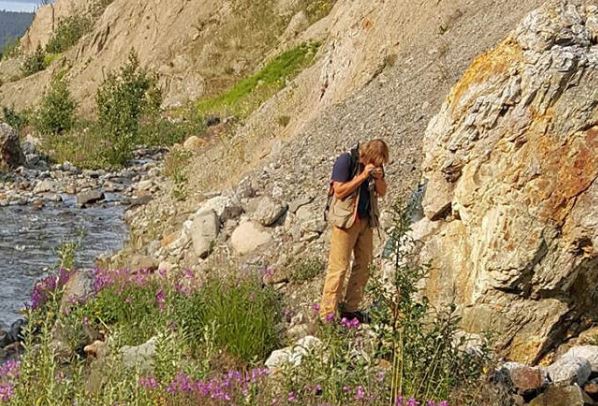Brixton to search for Atlin placer gold source

A Brixton geologist examines a rock sample at the Atlin Project in northwest British Columbia. Source: Brixton Metals Corp.
By Peter Kennedy

Brixton Metals Corp. [BBB-TSXV; BXTMF-OTC] said Thursday April 18 that it has started exploration work at its wholly-owned Atlin goldfields project near the town of Atlin in northwestern British Columbia, and within the traditional territory of the Taku River Tlingit First Nation.
Since 2016 Brixton has consolidated approximately 1,000 km2 of mineral claims, covering most of the Atlin gold camp, which has been a venue for placer gold production for the past 120 years.
Brixton’s goal is to discovery the bedrock sources for the gold mineralization using modern systematic exploration techniques.
Brixton is a precious metal exploration and development company with a focus on advancing its wholly-owned projects towards mine development. Its shareholder group includes Bay Street financier Rob McEwen, Pan American Silver Corp. [PAAS-TSX, NASDAQ], and Hecla Mining [HL-NYSE].
On Friday, the shares eased 3.45% or $0.005 to 14 cents. The 52-week range is 13 cents and 24 cents.
The company was in the news last year when it tabled initial drill results that the company said confirm the presence of high cobalt and low silver veins on its wholly-owned Hudson Bay Project, which is located near Cobalt in northeastern Ontario. Hudson Bay is part of what is known as the Langis-Hudson Bay silver-cobalt project. It was a high-grade silver mine with cobalt produced as a by-product. Hudson Bay is located near the Langis Mine, which produced over 10.4 million ounces of silver and 358,340 pounds of cobalt.
The Atlin gold project is an early stage gold exploration play in search of Barkerville-style or California-style mother-lode gold deposits, the company has said. It covers 979 km2.
The Atlin camp is the second largest gold producer in British Columbia on record, with a reported placer gold production of over 600,000 ounces between 1898 and 1946 from creeks in the area. It also holds the provincial record for the largest nugget, weighing 2.6 kilograms.
Several of the creeks crossing Brixton’s claims have seen historic placer production of up to 44,109 ounces on McKee Creek.
In 1988, Homestake Mineral Development Co. outlined the Yellowjacket gold zone by drilling 58 diamond drill holes, intersecting gold to a depth of 140 metres. More recently, samples taken by Brixton from the LD showing in 2017 returned a high of 293 g/t gold. By comparison, historical drilling in the Yellowjacket Zone returned up to 5.57 metres of 509.96 g/t gold.
On Thursday, Brixton said construction has begun on a new 35-person exploration camp located at the Yellowjacket Mine (a permitted 200-tonne-per-day mine and mill currently on care and maintenance). The mine is road accessible and located 9 km from the town of Atlin.
The company said exploration work planned for this year includes 3,000 metres of core drilling across four targets, including LD and Yellowjacket. The other two targets are Pictou and Imperial. Diamond drilling is expected to commence in late June. At LD and Pictou, a series of short drill holes will be utilized to test for vein continuity below historic trenches and to partially test gold-in-soil anomalies generated by Brixton in 2018.
The LD showing is approximately 12 km from Atlin and is road accessible. The Pictou showing, located 2 km from Atlin, is also road accessible. Historic records dating back to 1899 reveal the discovery of gold-bearing quartz veins through 29 metres of underground workings. Chip sampling of outcrop in the vicinity of the adit returned 11.75 g/t gold and 4.48 g/t gold last year.
